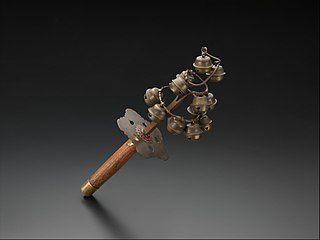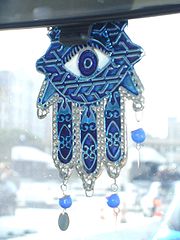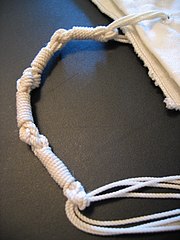Difference between revisions of "Language/Multiple-languages/Culture/Religions-and-Folklores:-Objects"
< Language | Multiple-languages | Culture
Jump to navigation
Jump to search
| Line 7: | Line 7: | ||
!religion/folklore | !religion/folklore | ||
!image | !image | ||
|- | |||
|agimat | |||
agimat | |||
|amulet | |||
| | |||
* Philippine folk religion | |||
* Philippine Christianity | |||
|https://upload.wikimedia.org/wikipedia/commons/thumb/8/8f/Quiapo_Talismans.jpg/320px-Quiapo_Talismans.jpg | |||
|- | |- | ||
|asabikeshiinh | |asabikeshiinh | ||
| Line 14: | Line 22: | ||
* Ojibwe folklore | * Ojibwe folklore | ||
|https://upload.wikimedia.org/wikipedia/commons/thumb/d/d4/Atrapasuenos.jpg/180px-Atrapasuenos.jpg | |https://upload.wikimedia.org/wikipedia/commons/thumb/d/d4/Atrapasuenos.jpg/180px-Atrapasuenos.jpg | ||
|- | |||
|daruma | |||
達磨 | |||
|talisman that returns to an upright position after being pushed, modeled after Bodhidharma; symbol of perseverance and resilience | |||
| | |||
* Zen Buddhism | |||
|https://upload.wikimedia.org/wikipedia/commons/thumb/c/c5/Koshigaya_Dharma_1.jpg/259px-Koshigaya_Dharma_1.jpg | |||
|- | |- | ||
|dharmachakra | |dharmachakra | ||
| Line 158: | Line 173: | ||
* Japanese Buddhism | * Japanese Buddhism | ||
|https://upload.wikimedia.org/wikipedia/commons/thumb/2/27/Variousomamori.jpg/320px-Variousomamori.jpg | |https://upload.wikimedia.org/wikipedia/commons/thumb/2/27/Variousomamori.jpg/320px-Variousomamori.jpg | ||
|- | |||
|Okiagari-kobōshi | |||
起き上がり小法師 | |||
|amulet that returns to an upright position after being pushed; symbol of perseverance and resilience | |||
| | |||
* Japanese folklore | |||
|https://upload.wikimedia.org/wikipedia/commons/thumb/f/f4/Okiagarikoboshi_from_Wakamatsu_%28cropped%29.jpg/190px-Okiagarikoboshi_from_Wakamatsu_%28cropped%29.jpg | |||
|- | |- | ||
|ōnusa, taima | |ōnusa, taima | ||
Revision as of 02:28, 8 July 2024

| Beings | Concepts | Events | Figures | Locations | Objects | Practices |
Generic
| object | description | religion/folklore | image |
|---|---|---|---|
| agimat
agimat |
amulet |
|

|
| asabikeshiinh
asabikeshiinh |
amulet of protective spiderweb for the children |
|

|
| daruma
達磨 |
talisman that returns to an upright position after being pushed, modeled after Bodhidharma; symbol of perseverance and resilience |
|

|
| dharmachakra
धर्मचक्र 法輪 ཆོས་ཀྱི་འཁོར་ལོ་ ธรรมจักร |
symbol of Buddhism; originally farming tool and weapon |
|

|
| ema
絵馬 |
wooden plaques for writing wishes |
|

|
| fúlù
符籙 |
talismanic slip |
|

|
| fūrin
風鈴 |
talisman of wind chimes |
|

|
| ghaṇṭā
घण्टा 犍稚 དྲིལ་བུ་ |
bell |
|

|
| gorgóneion
γοργόνειον |
amulet showing Gorgon head |
|

|
| gri-gug
གྲི་གུག་ |
ritual flaying knife |
|

|
| horseshoe | talisman; originally used for protecting horse hoofs |
|

|
| jangseung
長栍 |
totem pole |
|

|
| japamālā, mālā
जपमाला, माला 念珠 |
prayer beads |
|

|
| kagura suzu
神楽鈴 |
bells on a stuff used in kagura dances |
|

|
| khamsa
חמסה
خمسة
|
amulet against the evil eye |
|

|
| misbaḥa, subḥa
مِسْبَحَة، سُبْحَة
|
prayer beads |
|

|
| मूर्ति
mūrti |
devotional image |
|

|
| naẓar
نَظَر
|
amulet against the evil eye |
|

|
| ofuda
御札 |
talismanic slip |
|

|
| omamori
御守 |
amulet |
|

|
| Okiagari-kobōshi
起き上がり小法師 |
amulet that returns to an upright position after being pushed; symbol of perseverance and resilience |
|

|
| ōnusa, taima
大幣 |
wooden wand for ritual purification |
|

|
| ovoo, oboo
ᠣᠪᠤᠭᠠ
овоо |
shrine |
|

|
| rosarium
rosarium |
prayer beads |
|

|
| rúyì
如意 |
ceremonial scepter (Hàn Buddhism); talisman symbolising power and good fortune (Chinese folklore) |
|

|
| trollkors
trollkors |
amulet |
|

|
| tsitsít
צִיצִית
ࠑࠉࠑࠉࠕ
|
ritual fringes |
|

|
| vájra
वज्र 金剛杵 རྡོ་རྗེ། |
ceremonial mace |
|

|
Specific
| object | description | religion/folklore |
|---|---|---|
| Ārōn Hābrīt
אָרוֹן הָבְּרִית
|
wooden chest that contained Tablets of the Law |
|
| Excalibur | sword of King Arthur |
|
| Hama Yumi
破魔弓 |
sacred bow |
|
| Kusanagi no Tsurugi, Ame-no-Murakumo-no-Tsurugi
草薙劍、天叢雲剣 |
double-edged sword; imperial regalia |
|
| Lance of Longinus | lance that pierced the side of Jesus |
|
| Tevat Noaḥ
תֵּיבַת נֹחַ
Κιβωτός του Νώε Arca Noë سَفِينَةُ نُوحٍ
|
boat where Noah, his family and selected creatures survived a global flood |
|
| True Cross | real cross that Jesus of Nazareth was crucified on |
|
| Xuānyuánjiàn
軒轅劍 |
double-edged sword of Huángdì |
|
| Yasakani no Magatama
八尺瓊勾玉、八尺瓊曲玉、八坂瓊曲玉 |
jade; imperial regalia |
|
| Yata no Kagami
八咫鏡 |
mirror; imperial regalia |
|

| Beings | Concepts | Events | Figures | Locations | Objects | Practices |